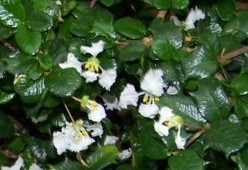 A native of the West Indies, this is an evergreen shrub that is also called Singapore holly. It has small shiny-green leaves that have spiny-toothed edges and resemble those of holly, giving the plant it’s common names, but in fact, it is not a holly or even related. Throughout the year light pink, dime-sized flowers are produced sporadically and may be followed by pea sized red berries. The wiry branches are open and have gray-white bark. This is not an easy plant for bonsai because of its demanding requirements and its tendency to drop its leaves when the requirements are not met. All the classic styles are possible but the broom style is challenging and requires careful selective pruning.
A native of the West Indies, this is an evergreen shrub that is also called Singapore holly. It has small shiny-green leaves that have spiny-toothed edges and resemble those of holly, giving the plant it’s common names, but in fact, it is not a holly or even related. Throughout the year light pink, dime-sized flowers are produced sporadically and may be followed by pea sized red berries. The wiry branches are open and have gray-white bark. This is not an easy plant for bonsai because of its demanding requirements and its tendency to drop its leaves when the requirements are not met. All the classic styles are possible but the broom style is challenging and requires careful selective pruning.
 Position: Plants can be grown indoors all year but need bright light with protection from direct sun. In spring, they can be placed outdoors in shade to part shade with protection from noon sun. The temperature in the winter ideally should be between 64o and 75F with 50% humidity, although plants will tolerate temperatures to 57F. Miniature holly likes warm soil and growing it on a heating pad so that the soil temperature does not fall below 72o F. is recommended.
Position: Plants can be grown indoors all year but need bright light with protection from direct sun. In spring, they can be placed outdoors in shade to part shade with protection from noon sun. The temperature in the winter ideally should be between 64o and 75F with 50% humidity, although plants will tolerate temperatures to 57F. Miniature holly likes warm soil and growing it on a heating pad so that the soil temperature does not fall below 72o F. is recommended.
 Water: The soil should be kept evenly moist with rain water at room temperature. Under- or over-watering results in leaf drop.
Water: The soil should be kept evenly moist with rain water at room temperature. Under- or over-watering results in leaf drop.
 Fertilizer: From spring to autumn feed every three weeks with an organic fertilizer. In winter feed every four to six weeks with the same fertilizer.
Fertilizer: From spring to autumn feed every three weeks with an organic fertilizer. In winter feed every four to six weeks with the same fertilizer.
 Repotting: Repot into the same size pot every one to two years in the spring. Vigorous root pruning should be done at the same time because the roots grow rapidly.
Repotting: Repot into the same size pot every one to two years in the spring. Vigorous root pruning should be done at the same time because the roots grow rapidly.
 Soil: Use a bonsai soil or a mix of loam, peat moss, and sand at a ratio of 2:1:1 .
Soil: Use a bonsai soil or a mix of loam, peat moss, and sand at a ratio of 2:1:1 .
 Pruning: Any time during the year when the branches become lignified (woody), shoots with five to six pairs of leaves can be cut back to one to two pairs of leaves. All small leaves on the trunk and branches, and inside the crown should be cut or rubbed off.
Pruning: Any time during the year when the branches become lignified (woody), shoots with five to six pairs of leaves can be cut back to one to two pairs of leaves. All small leaves on the trunk and branches, and inside the crown should be cut or rubbed off.
 Wiring: When young branches have become lignified they can be wired; branches more than two years old are usually too inflexible to wire so start when the plant is young.
Wiring: When young branches have become lignified they can be wired; branches more than two years old are usually too inflexible to wire so start when the plant is young.
 Propagation: Hard- or softwood cuttings, root cuttings taken in summer, layering, all done with warm soil; seed (low availability).
Propagation: Hard- or softwood cuttings, root cuttings taken in summer, layering, all done with warm soil; seed (low availability).
 Comments: Pest prone; watch out for aphids, spider mites; soil nematodes.
Comments: Pest prone; watch out for aphids, spider mites; soil nematodes.
